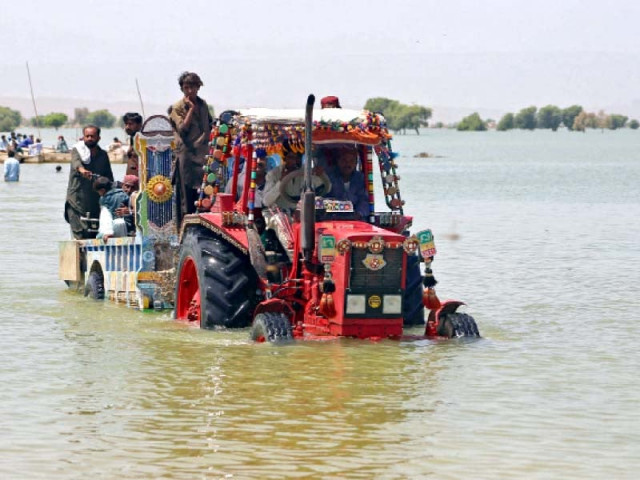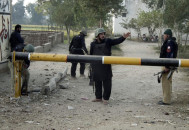Slow-moving tsunami puts pressure on Sehwan
50 villages in Nawabshah district flooded; authorities on alert in Jamshoro

Authorities were on a very high alert to save Sehwan town from flooding on the right bank of the Indus river, while a slow-moving tsunami of floodwaters on the left bank inundated 50 villages near Gupchani in Nawabshah district on Friday.
Thousands of people were forced to leave their homes in haste and take shelter on higher ground on both the sides of the mighty river. In Mehar town of the Dadu district, the local residents were building dikes to prevent the flood tide coming from Khairpur Nathan Shah from entering the town.
In Nawabshah, the floodwater had also submerged the Nawabshah-Sanghar road. The outfall drains in the area also overflowed, further aggravating the situation. Locals said that the floodwater flow continued in the district.
On the other side of the Indus, the floodwater from Balochistan headed towards the Manchhar lake, near Sehwan in Jamshoro district via the Main Nara Valley (MNV) drain, after ravaging Kambar-Shahdadkot and Dadu districts.
Jamshoro Deputy Commissioner Capt (retd) Fariduddin Mustafa said that the next 24 hours would be very crucial and that the administration might ask the people to move out of their homes to go to safer places.
The water level was constantly rising in Manchhar – the country’s largest freshwater lake. The local people and irrigation staff remained engaged in reinforcing the levees of the lake with stones and sandbags. The town of Bubak faced the highest risk of flooding.
Officials said that five union councils close to the lake might be inundated if Manchhar’s embankment was ruptured or it started overflowing. The village of Sindh Chief Minister Syed Murad Ali Shah and the Sehwan airport also faced threat of flooding.
In Dadu, several villages were under as much as 11 feet of water, according to a local resident. In Mehar, near the already flooded Khairpur Nathan Shah, residents were building a dike in an attempt to prevent floodwaters from entering the town, he said.
Further up, evacuation continued in the Warah town of Kambar Shahdadkot district, where flood appeared imminent. Thousands of people were seen leaving the town via trucks, tractors and other vehicles as well as on foot.
Read Govt mulls taking another IMF loan for floods
The evacuation started after the deputy commissioner of the district issued an alert, advising the people to move to safer places. Kambar road, which provided the only exit from the town, remained surrounded by water. Navy helicopters also joined rescue operation in Warah.
In Mirpurkhas district, meanwhile, a 100-foot breach in the Puran river at Teddy Mori near the town of Jhudo, inundated dozens of adjacent villages. The water was passing over the Jhudo-Mirpurkhas road – the only link between the town and other districts.
Indus rising
The water level was also increasing in the Indus river, which was in medium flood. The irrigation officials said that there was no threat of riverine floods, as the water flow was expected to attain a peak of 600,000 cusecs at Kotri – the last barrage on the Indus before sea.
According to official data, the flood level at the three barrages of Sindh – Guddu, Sukkur and Kotri – showed a slight increase as new torrents from the northern parts of the country entered the lower riparian province.
The irrigation department recorded a flow of 558,218 cubic feet per second (cusecs) at Guddu, up from 540,493 cusecs on Thursday; 531,865 cusecs at Sukkur, slightly up from 529,817 cusecs the other day; and 447,024 cusecs at Kotri, up from 438,162 cusecs 24 hours ago.
The irrigation authorities said the flood had now reached the medium level in the river. In 2010 more than 900,000 cusecs flowed through Kotri but according to some estimates the water level was 1.1 million cusecs.
Plight of marooned people
Record monsoon rains and melting glaciers in northern mountains brought floods that have killed at least 1,208 people, including 416 children, the National Disaster Management Authority (NDMA) has said.
The armed forces said they rescued a further 2,000 people stranded by rising floodwaters, while the Edhi Foundation warned that the situation was serious, as “90% people are still awaiting any kind of assistance” and that “people are starving”.
Faisal Edhi, the head of the Edhi Foundation, who spent the last nine days in the flood-hit areas, described the situation as grim and called on the government to lift a years-old ban on some international NGOs.
“The situation is very bad, and it seems it will worsen,” Edhi told reporters. “Pakistan is struggling to respond to the floods given their unprecedented magnitude. The government has said 33 million people – 15% of population – have been affected.”
The UN children’s agency Unicef said on Friday many more children could die from disease. “There is now a high risk of water-borne, deadly diseases spreading rapidly—diarrhoea, cholera, dengue, malaria,” UNICEF Pakistan Representative Abdullah Fadil told a Geneva press briefing. “There is therefore a risk of many more child deaths,” he said.
(WITH INPUT FROM REUTERS)



















COMMENTS
Comments are moderated and generally will be posted if they are on-topic and not abusive.
For more information, please see our Comments FAQ